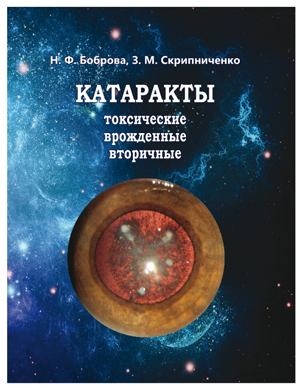J.ophthalmol.(Ukraine).2017;3:72.
|
https://doi.org/10.31288/oftalmolzh2017372
The monograph by Prof. Nadezhda F. Bobrova and Prof. Zinaida M. Skripnichenko is devoted to a current issue of ophthalmology, which is surgical treatment for various cataracts including toxic, congenital, secondary ones. The paper consists of seven parts on etiology, clinic, classification, and surgical technique features for each type of cataract. Relevance and social importance of the problem represented in the monograph is caused by significant incidence of lens disorders in children and adults and by the fact that ill-timed and inadequate eye care delivery can result in impaired vision and blindness. The monograph contains informative graphs and tables, systematizing the factual material. All the techniques of surgical interventions are illustrated with clinical examples with colored pictures, which make it possible to assess the possibilities of the methods described and the effectiveness of their application in the clinical practice. Of a special interest for professional reader are the parts devoted to rare congenital lens pathologyies: atypical cataracts, micro- and spherophakia, anterior and posterior lenticonus, and congenital ectopia lentis since the authors describe originally developed surgical techniques in addition to a detailed description of the clinical features. A most singular case of congenital pathology of the anterior eye, acoria, has been described with the technique for its surgical treatment which is the formation of the pupil in the transparent lens. Also, much interest will be attracted to a case of phimosis of the anterior capsulorhexis hole and an operative method with the recovery of optic axis transparency. The issues on congenital cataracts are given in details and in natural sequence: from morphological and clinical-surgical classification, characteristics of examination and IOL optical power calculation in infants to details of surgical techniques and methods for prophylaxis and treatment of complications which are specific for infancy. Results of authors’ many-year research, represented in the monograph, draw a great attention of a wide range of ophthalmologists, who are involved in examination and treatment of cataract patients in their practice. Ophthalmology specialists to be introduced the results of deep analysis of the wide clinical material and new surgical treatments will facilitate the improvements in their professional level and in organization of ophthalmic care delivery to the cataract patients. Corr. member of NAS and NAMS of Ukraine Dr. Sc. (Med.), Professor, N. M. Sergiienko Ophthalmology Department Shupyk National Medical Academy of Postgraduate Education
|

 Review of “Cataract: toxic, congenital, secondary”, a monograph by N.F. Bobrova and Z. M. Skripnichenko
Review of “Cataract: toxic, congenital, secondary”, a monograph by N.F. Bobrova and Z. M. Skripnichenko